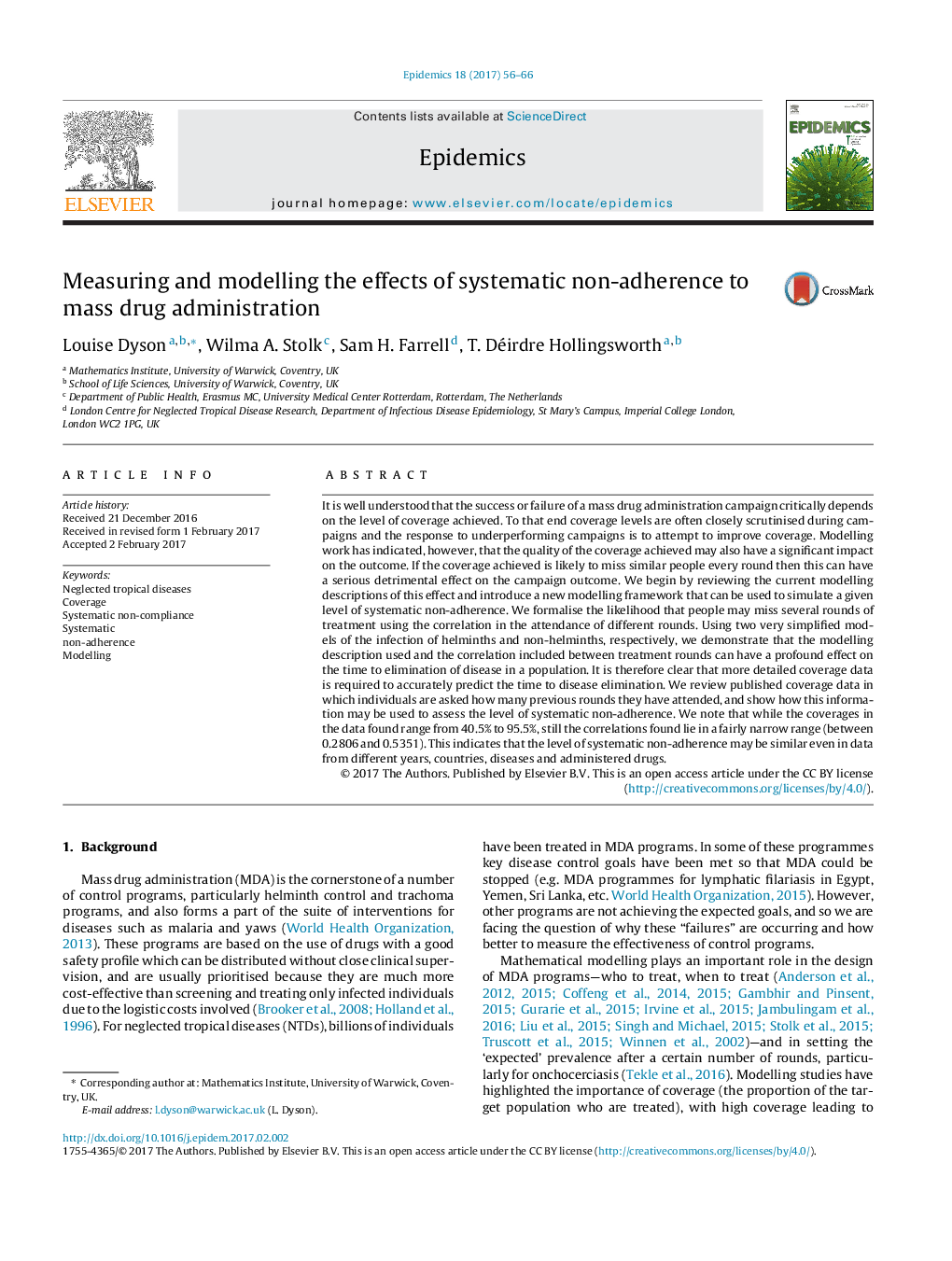| کد مقاله | کد نشریه | سال انتشار | مقاله انگلیسی | نسخه تمام متن |
|---|---|---|---|---|
| 5588960 | 1569429 | 2017 | 11 صفحه PDF | دانلود رایگان |
عنوان انگلیسی مقاله ISI
Measuring and modelling the effects of systematic non-adherence to mass drug administration
ترجمه فارسی عنوان
اندازه گیری و مدل سازی اثرات عدم پیوستگی سیستماتیک به تجویز مواد مخدر
دانلود مقاله + سفارش ترجمه
دانلود مقاله ISI انگلیسی
رایگان برای ایرانیان
کلمات کلیدی
بیماری های گرمسیری نادیده گرفته شده، پوشش، عدم انطباق سیستماتیک، نظام، عدم پایبندی، مدل سازی،
ترجمه چکیده
به خوبی درک می شود که موفقیت یا شکست یک مبارزات انتخاباتی مبارزه با مواد مخدر، به میزان قابل توجهی بستگی به سطح پوشش دارد. به این ترتیب سطح پوشش معمولا در طول مبارزات دقیق مورد بررسی قرار می گیرد و پاسخ به کمپین های ناموفق نیز تلاش برای بهبود پوشش است. با این حال، کار مدل سازی نشان داده است که کیفیت پوشش داده شده نیز ممکن است بر نتایج تاثیر بگذارد. اگر پوشش به دست آمده احتمالا در هر دور از دست رفته مردم مشابه باشد، این امر می تواند تاثیر مخربی جدی بر نتیجه انتخابات داشته باشد. ما با مرور توصیف های مدل سازی فعلی این اثر و ارائه یک چارچوب مدل سازی جدید که می تواند برای شبیه سازی سطح داده شده از عدم پذیرش سیستماتیک استفاده شود، آغاز می شود. ما احتمال این که مردم ممکن است چندین دور درمان را از دست بدهند با استفاده از همبستگی در حضور دورهای مختلف، رسمی کنیم. بدین ترتیب، با استفاده از دو مدل بسیار ساده از عفونت های کلمنت ها و غیر کلامیدی ها، ما نشان می دهیم که شرح مدل سازی مورد استفاده قرار گرفته است و همبستگی بین دوره های درمان می تواند تاثیر عمیقی بر زمان برطرف شدن بیماری در یک جمعیت داشته باشد. بدین ترتیب واضح است که اطلاعات دقیق پوشش برای پیش بینی دقیق زمان برای از بین بردن بیماری لازم است. ما دادههای مربوط به پوشش داده شده را بررسی می کنیم که از آنها خواسته می شود که تعداد دفعات قبلی آنها حضور داشته باشد و نشان دهد چگونه این اطلاعات ممکن است برای ارزیابی سطح عدم پذیرش سیستماتیک استفاده شود. ما متوجه می شویم که در حالی که پوشش داده ها در محدوده بین 40.5٪ تا 95.5٪ است، همبستگی ها در محدوده نسبتا باریک (بین 0.2806 و 0.5351) قرار دارند. این نشان می دهد که سطح عدم پذیرش سیستماتیک ممکن است حتی در داده های سال های مختلف، کشورهای، بیماری ها و داروهای اداری مشابه باشد.
موضوعات مرتبط
علوم زیستی و بیوفناوری
علوم کشاورزی و بیولوژیک
بوم شناسی، تکامل، رفتار و سامانه شناسی
چکیده انگلیسی
It is well understood that the success or failure of a mass drug administration campaign critically depends on the level of coverage achieved. To that end coverage levels are often closely scrutinised during campaigns and the response to underperforming campaigns is to attempt to improve coverage. Modelling work has indicated, however, that the quality of the coverage achieved may also have a significant impact on the outcome. If the coverage achieved is likely to miss similar people every round then this can have a serious detrimental effect on the campaign outcome. We begin by reviewing the current modelling descriptions of this effect and introduce a new modelling framework that can be used to simulate a given level of systematic non-adherence. We formalise the likelihood that people may miss several rounds of treatment using the correlation in the attendance of different rounds. Using two very simplified models of the infection of helminths and non-helminths, respectively, we demonstrate that the modelling description used and the correlation included between treatment rounds can have a profound effect on the time to elimination of disease in a population. It is therefore clear that more detailed coverage data is required to accurately predict the time to disease elimination. We review published coverage data in which individuals are asked how many previous rounds they have attended, and show how this information may be used to assess the level of systematic non-adherence. We note that while the coverages in the data found range from 40.5% to 95.5%, still the correlations found lie in a fairly narrow range (between 0.2806 and 0.5351). This indicates that the level of systematic non-adherence may be similar even in data from different years, countries, diseases and administered drugs.
ناشر
Database: Elsevier - ScienceDirect (ساینس دایرکت)
Journal: Epidemics - Volume 18, March 2017, Pages 56-66
Journal: Epidemics - Volume 18, March 2017, Pages 56-66
نویسندگان
Louise Dyson, Wilma A. Stolk, Sam H. Farrell, T. Déirdre Hollingsworth,
